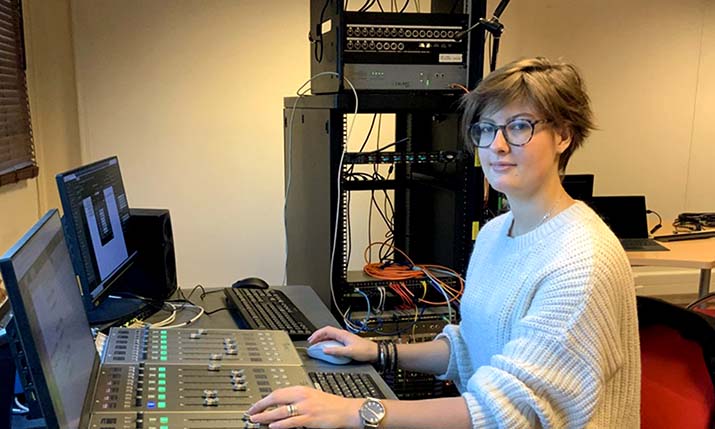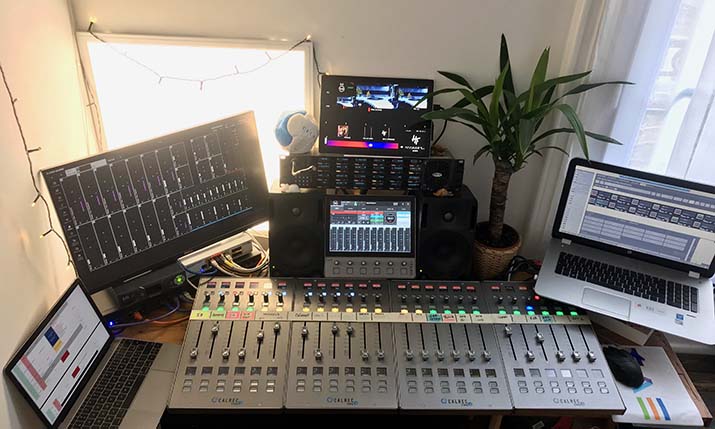Big reverberations: Sound operator Marine Martignac on solving problems and finding technical solutions
International Women's Day 2021 focus

Marine Martignac, freelance sound operator
Marine Martignac graduated in audio and broadcast in 2016 and has made a big impact. She was very quickly snapped up as a part-time engineer by OB specialists Boîte à Outils Broadcast (BOB) and simultaneously started as a freelancer, first for Imagina France (now Mediapro), more recently adding the likes of France Télévisions, Masterfilms, CFRT, AMP Visual TV (for beIN Sport France), and Mediapro’s own Téléfoot channel to her client portfolio. Most of Matignac’s freelance activities are as a sound operator.
“Mediapro is the technical service provider for the contribution side of the top two football leagues in France,” she explains. “There I am responsible for setting up the OB van as well as patching the sources, configuring intercoms before the match, and mixing the international feed during the matches.
“I want to continue with production sound, but I am also starting to take on some bigger engineering and integration projects; creating control rooms and OB vans. I don’t want to choose between the two jobs and I think my operating experience is great for the integration business”
“For Téléfoot I mix all non-voice sources like the playout servers, music, international versions, and so on. I also have to manage the intercom for the control room.
“In my work with AMP Visual TV for beIN Sport I mix various European football competitions as well as some US sports, such as the NBA.”
Roland Garros to synchronised swimming
Martignac splits her time between these and other freelance sound operator jobs, and her role in integration and broadcast services for BOB. “At BOB we provide control room and OB integration services, as well as large event recordings,” says Martignac. “These include Roland Garros, synchronised swimming championships, and futsal [a football game played on a hard court] in sport, but also cultural events like fashion shows, opera, and theatre performances.”
The integration side of the business is an aspect that Martignac feels contributes a lot to her role as a broadcast engineer, and that both this and her operating experience are complementary. “I want to continue with production sound, but I am also starting to take on some bigger engineering and integration projects; creating control rooms and OB vans. I don’t want to choose between the two jobs and I think my operating experience is great for the integration business. Someone who is working in the real world and who understands the day-to-day challenges is best placed to come up with practical solutions.”
She continues: “At BOB we focus on our customer needs and then deploy every human and material resource we have to meet those needs. This goes from designing a flypack to a fixed control room. I could be providing a service or working in the design office and contributing to tender invitations.”

The Canal+ set up designed by Marine Martignac in the first lockdown of 2020, with a Calrec Type R core and a Clearcom matrix
Remote production challenges
Quite understandably, much of what has dominated Matignac’s current sound operator and integration projects has been remote production, whether it be providing remote facilities for others, or operating remotely herself, from her own home facility.
“It’s always a pleasure to create a path or solution. Everything is possible but you have to understand the technology to find a good solution”
One project that combined both of these was for a current Canal+ project. Canal+ had previously installed a Calrec Brio 36 on her recommendation three years ago, which became the foundation for this project. She explains: “During the first lockdown we proposed a remote production set up so we could follow the new protocols and not interrupt filming. We designed a set up with a Calrec Type R core and a Clearcom matrix that could be used for remote production using just a computer or the Type R control panels without transporting programme audio; only monitoring.
“This means we have limited bandwidth requirements, but there is no sacrifice in quality of the main feeds.”
According to Matignac, this first project was a catalyst for a number of subsequent remote production installations in quick succession. “For the Open de France de Natation Artistique [artistic swimming championship] again we were asked for simplified production system. We used a Type R with a single fader pack and monitor, plus a computer for configuration. I created a page on-screen with a fader path and mute function for setting the level of each commentary position, video, and overall mix. The Calrec Assist html remote control facility allowed me to take control remotely if anything went wrong during the show.
“Importantly, the Type R has native SMPTE 2110 connectivity; undeniably the future of networked audio transport in broadcast production.”
For Matignac, considerations such as control latency and audio transport have turned out to be less problematic than other more logistic considerations. These included the issue of finding networked monitoring tools, and of peripheral control. “We need to have access to all software to manage everything in the sound control room,” notes Martignac. “Like the matrix, the HF receiver, the sampler, the amplifier, and so on.”
Problems and technical solutions
It is problems and technical solutions that seem to drive Martignac, she says: “It’s always a pleasure to create a path or solution. Everything is possible but you have to understand the technology to find a good solution. I enjoy those challenges. I enjoy exploiting technology for advantage.
Being a woman in an utterly male-dominated industry might seem a daunting prospect, with expectations of ill-conceived assumptions and opportunity limited by ignorance, but that has not been Martignac’s experience. “I have been well supported and welcomed by the technical broadcast community, and my immediate colleagues. Of course, there are exceptions, but on the whole it has been positive.
“On the other hand, clients seem to have different expectations. They still seem to expect a man with 30 years’ experience, not a young woman.”
Matignac hopes that will changes as more women are welcomed into the industry. “There are not a lot of women in the broadcast world, but women should not be afraid to jump in. If you know what you want, it’s important to insist on it. There are a lot of people who can help you to succeed. In broadcast our job is a job of passion. And passion has no gender. Diversity is a richness”
